Section 1
1. Section 1
1.17. Explore
Section 1: Viewing and Representing 3-D Objects
Explore
The views you used to build 3-D objects in Discover are often referred to as orthographic views. The word ortho means “perpendicular.” Each view is perpendicular, or at a 90° angle to another side.
- The top view is perpendicular to front and side views.
- The front view is perpendicular to top and side views.
- The side view is perpendicular to top and front views.

Think of a cube. Each orthographic view could fit into a cube since the front, the right side, and the top all meet at right angles.
Remember that an orthographic view is a two-dimensional representation. You may need one, two, three, or all six views to represent the original object.
Notice how many views are required to represent each object in the rest of this lesson.
Try This 2
What three-dimensional object do the following views define? Follow the steps to draw the object on isometric dot paper.

Step 1: First, determine the maximum dimensions of the object. ![]()
Step 2: Second, sketch in a prism on isometric dot paper with these maximum dimensions.
Step 3: Last, add and erase lines until the figure is complete. Check your drawing. ![]()
![]() Save your drawing to your course folder.
Save your drawing to your course folder.

The three-dimensional object is a set of stairs.